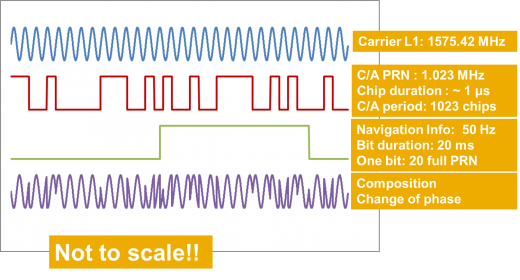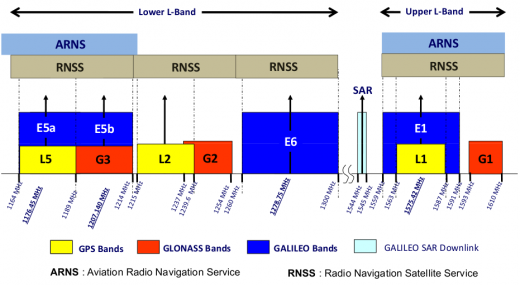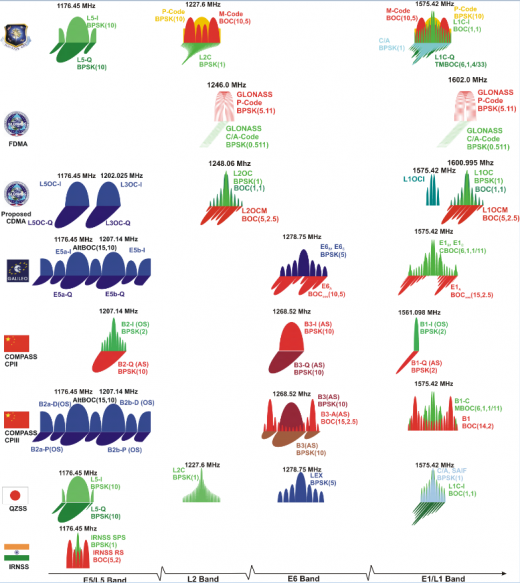If you wish to contribute or participate in the discussions about articles you are invited to contact the Editor
GNSS signal: Difference between revisions
Carlos.Lopez (talk | contribs) No edit summary |
m (→Introduction) |
||
| (One intermediate revision by one other user not shown) | |||
| Line 14: | Line 14: | ||
*'' Navigation data'': A binary-coded message providing information on the satellite ephemeris (Keplerian elements or satellite position and velocity), clock bias parameters, almanac (with a reduced accuracy ephemeris data set), satellite health status, and other complementary information. | *'' Navigation data'': A binary-coded message providing information on the satellite ephemeris (Keplerian elements or satellite position and velocity), clock bias parameters, almanac (with a reduced accuracy ephemeris data set), satellite health status, and other complementary information. | ||
As an example, the main components of GPS L1 C/A signal are represented on figure 1. | |||
::[[File:GPS Signals.png|none|thumb|520px|alt=GPS L1 C/A signal |'''''Figure 1''''': Main components of GPS L1 C/A signal.]] | |||
| Line 19: | Line 23: | ||
ITU has been working in the allocation of the radio-frequency bands used by the Radio Navigation Satellite Services (RNSS) where GNSS belongs to. Allocation agreements were output from the World Radio Communication Conferences in 2000 and 2003. | ITU has been working in the allocation of the radio-frequency bands used by the Radio Navigation Satellite Services (RNSS) where GNSS belongs to. Allocation agreements were output from the World Radio Communication Conferences in 2000 and 2003. | ||
::[[File:GNSS navigational frequency bands.png|none|thumb|520px|alt=GNSS navigational frequency bands|'''''Figure | ::[[File:GNSS navigational frequency bands.png|none|thumb|520px|alt=GNSS navigational frequency bands|'''''Figure 2''''': GPS, GLONASS and Galileo navigational frequency bands.]] | ||
Figure 2 shows the frequency bands for the Radio Navigation Satellite System (RNSS). There are two bands in the region allocated to the Aeronautical Radio Navigation Service (ARNS) on a primary basis worldwide. These bands are especially suitable for Safety-of-Life applications because no other users are allowed to interfere with their signals. They correspond to the upper L band (1 559 - 1 610 MHz), having the GPS L1, Galileo E1 and GLONASS G1, and to the bottom of the Lower Band-L (1 151 - 1 214 MHz) where GPS L5 and Galileo E5 are located, with E5a and L5 coexisting in the same frequencies. The remaining GPS L2, GLONASS G2 and Galileo E6 signals are in the bands 1 215.6 - 1 350 MHz. These bands were allocated to Radio-location Services (ground radars) and RNSS on a primary basis, thence the signals in these bands are more vulnerable to interference than the previous ones. | |||
Figure 3 shows the frequency bands used by the different GNSS systems | |||
::[[File:GNSS_All_Signals.png|none|thumb|520px|alt=GNSS frequency bands|'''''Figure 3''''': GNSS frequency bands. (Source: Stefan Wallner)]] | |||
==Related articles== | ==Related articles== | ||
Latest revision as of 10:14, 30 May 2014
| Fundamentals | |
|---|---|
| Title | GNSS signal |
| Author(s) | J. Sanz Subirana, JM. Juan Zornoza and M. Hernandez-Pajares, University of Catalunia, Spain. |
| Level | Basic |
| Year of Publication | 2011 |
Introduction
The GNSS satellites continuously transmit navigation signals in two or more frequencies in L band. These signals contain ranging codes and navigation data to allow the users to compute the travelling time from satellite to receiver and the satellite coordinates at any epoch. The main signal components are described as follows:
- Carrier: Radio frequency sinusoidal signal at a given frequency.
- Ranging code: Sequences of 0s and 1s (zeroes and ones), which allow the receiver to determine the travel time of radio signal from satellite to receiver. They are called Pseudo-Random Noise (PRN) sequences or PRN codes.
- Navigation data: A binary-coded message providing information on the satellite ephemeris (Keplerian elements or satellite position and velocity), clock bias parameters, almanac (with a reduced accuracy ephemeris data set), satellite health status, and other complementary information.
As an example, the main components of GPS L1 C/A signal are represented on figure 1.
Frequencies allocation: The allocation of frequency bands is a complex process because multiple services and users can coexist in the same range. That is, the same frequencies can be allocated for different purposes in different countries. The International Telecommunications Union (ITU) is a United Nations agency coordinating the shared global use of the radio spectrum. It involves, for instance, television, radio, cell-phone, radar satellite broadcasting, etc., and even microwave ovens.
ITU has been working in the allocation of the radio-frequency bands used by the Radio Navigation Satellite Services (RNSS) where GNSS belongs to. Allocation agreements were output from the World Radio Communication Conferences in 2000 and 2003.
Figure 2 shows the frequency bands for the Radio Navigation Satellite System (RNSS). There are two bands in the region allocated to the Aeronautical Radio Navigation Service (ARNS) on a primary basis worldwide. These bands are especially suitable for Safety-of-Life applications because no other users are allowed to interfere with their signals. They correspond to the upper L band (1 559 - 1 610 MHz), having the GPS L1, Galileo E1 and GLONASS G1, and to the bottom of the Lower Band-L (1 151 - 1 214 MHz) where GPS L5 and Galileo E5 are located, with E5a and L5 coexisting in the same frequencies. The remaining GPS L2, GLONASS G2 and Galileo E6 signals are in the bands 1 215.6 - 1 350 MHz. These bands were allocated to Radio-location Services (ground radars) and RNSS on a primary basis, thence the signals in these bands are more vulnerable to interference than the previous ones.
Figure 3 shows the frequency bands used by the different GNSS systems
Related articles
For further information on the the GPS, GLONASS and Galileo signals, please visit the following links:



